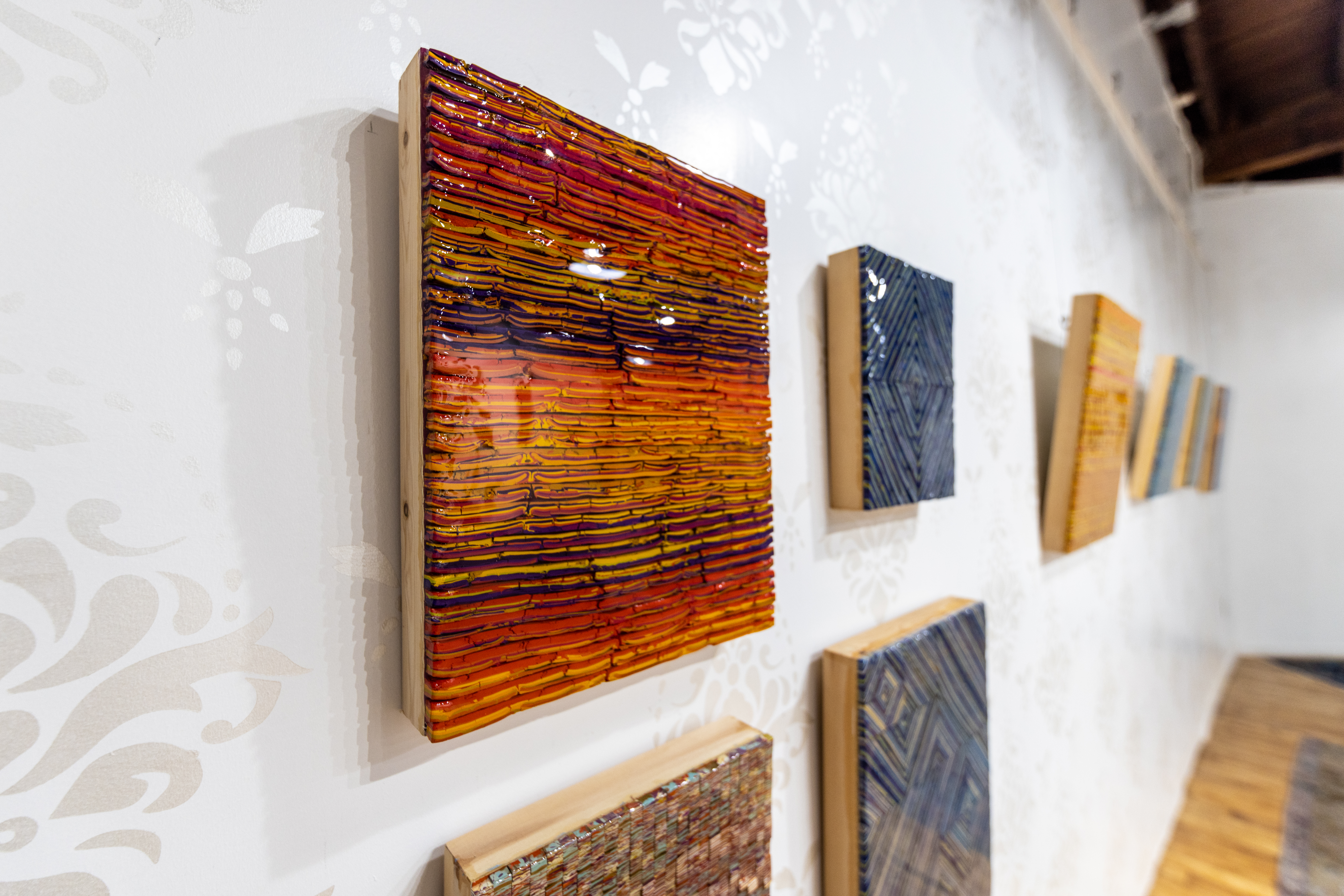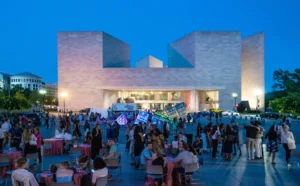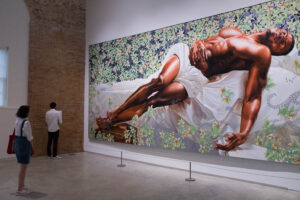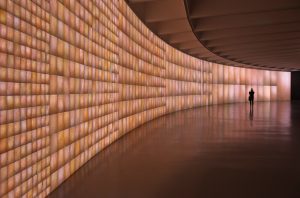Once a warehouse, the unassuming brick building sitting in the corner of NoMa on 52 O Street is now home to a variety of art studios and galleries. One of them is Morton Fine Art, which just launched Ai Yo!, a selection of 21 sculptural paintings by artist Jenny Wu. The gallery is spacious and well lit, and the walls are decked with Wu’s colorful works. I was not entirely sure what a sculptural painting entailed, but I was curious to learn more.
“Hundreds of people came for the opening day,” Amy Morton, curator of Morton Fine Art, said. I can see why: the works are fun and unconventional. Wu creates her art by pouring layers of latex paint on top of each other, a technique that she told the Voice took her almost a decade of trial and error to develop. Once the layers have dried—a process which can take up to four months—Wu slices the sheets into varying sizes and meticulously rearranges them on top of a wooden panel to create patterns. She then applies a resin coating over the whole contraption to add a glossy finish. The result is many colorful, mosaic-esque creations of varying color schemes and patterns.
Wu’s creative combination of painting and sculpture makes her work quite the treat to see in person, as one can more closely see the textures and topography created by the latex chunks. The drying and cutting process leads to cracks and imperfections in the individual latex units, meaning no two fragments are identical.
“The paint crinkles quickly, and the liquid paint becomes something I can hold,” Wu said.
The centimeter-sized latex cube sample Morton hands me to examine resembles a vibrant chunk of sedimentary rock or a soil specimen. It has the quiet elasticity of a bouncy ball or firm eraser. Considering that Wu uses these three dimensional units to create her visual art as opposed to a more traditional medium like paint, it is clear “sculptural painting” is an apt term to describe her work. By using these latex layers as her instrument of creation, Wu liquifies the boundaries between the two media.
“They really need to be experienced in person, because it is very hard to capture the textures and colors with just a photo,” Morton said.
Regarding the title of the exhibit, Wu explains that the phrase Ai Yo! is an interjection used in many different situations in her hometown in China, from communicating feelings of awe to displeasure.
“The meaning depends on the context. It is both general and specific,” Wu said. “I think most human beings, when they look at those four letters together, they can pronounce it in some way, even if they don’t speak Chinese. You can pronounce it any way you want, as long as it adds emotion.”
The inclusive and welcoming nature of the exhibit title leaves a lot of space for viewers to interpret the pieces, proving that Wu’s art is something that transcends language barriers.
After going to graduate school at American University, Wu found that there were more galleries and organizations focused on promoting smaller artists here in D.C. compared to other places. Given the political and international significance of D.C., Morton remarks that it’s “important to keep the conversation expanding through art and push museum tipping points.” Galleries like Morton Fine Arts and the artists that they partner with are critical in continuing to expand the boundaries of art and make meaningful statements about the world we live in.
Wu’s mission complements that of Morton Fine Art curator Amy Morton’s well, resulting in a synergistic collaboration. Morton chooses her artist partners with careful deliberation, looking for “substantive artwork that is both timeless and timely.” Wu’s work fits the bill, leaving a lasting impression through the unique medium and jarring titles. The political overtones of her work reflect aspects of the local cultural climate, arising naturally out of the close proximity to Capitol Hill. Both Morton and Wu agree that the D.C. art scene is not as bustling or developed as, say, New York City, but the city is fertile ground for emerging artists.
The artwork titles are equally delightful and thought-provoking as the visual components. Wu draws inspiration for these creative titles from Twitter, Instagram, and other forms of social media. “I want my titles to be more abstract, rather than purely descriptive, so they can create more space,” says Wu.
Though all of these pieces are abstract, their titles provide much food for thought that prompts the onlooker to think about the pieces more deeply. Some titles are humorous, like “70 Year Old Intern Waiting for His First Real Job” (2022). For this piece, Wu has arranged long warm toned strips with slices of green in the middle into hexagons, juxtaposing the chaos of the latex strips with the order of the polygons for a sense of contained frustration. Others are damning, like “Spent $50.4 Million on TV Ads to Brag About Giving Local Businesses A Total of $100,000” (2022). This piece is an amalgamation of small red, white, and blue pieces that emanates a more chaotic, overtly political energy.
“Ruthkanda Forever” (2022) and “Carefully Editing an Email Response” (2021) stand out in particular. The latex layers that make up “Ruthkanda Forever” are varying shades of blue with the occasional yellow stripe, arranged in a lightly undulating formation. From a distance, the piece looks like gently rolling ocean waters reflecting moonlight, which, when combined with the title, perhaps represents how our collective pop culture consciousness has digested and lionized RBG and the Black Panther franchise. “Carefully Editing an Email Response” features paint strata delicately arranged in tessellating hexagons, resembling the rigid and meticulous process of combing through a professional email for typos. Other interesting titles include “$1200 That Should Be More Than Enough” (2022) and “I Will Not Get Bit By Capitol Fox” (2022). Georgetown students are sure to get a kick out of the latter, considering the heavy political preprofessional inclinations of the general community.
One way Wu pushes artistic boundaries is by exploring different usages of color.
“Right now, the way I choose colors is more based on the aesthetic. Like, if I do some purple with some blue, a little hint of orange might look good in there based on the similarity of the colors. But I want to explore more ways of combining colors and patterns together,” Wu said.
Whatever direction Wu takes her work in, she will continue to push boundaries and set new creative benchmarks. Any vaguely art-curious Georgetown students should be sure to take advantage of the opportunities we have in DC and explore the unique flavors of local art here.





